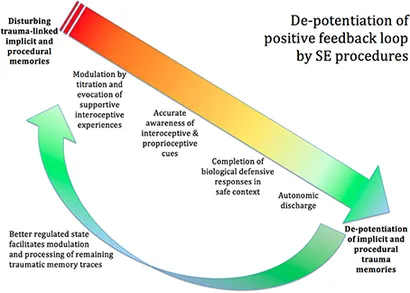Somatic Experiencing (SE) is a body–mind approach to healing trauma that focuses on helping people reconnect with and befriend their bodies. Instead of asking clients to re-tell or relive painful memories, SE uses the body as the gateway to healing, guiding individuals toward safety, regulation, and resilience.
In SE, clients are guided to notice and gently explore their bodily experiences, which fall into three main categories:
-
Interoceptive – internal sensations (such as heartbeat, breath, gut feelings)
-
Proprioceptive – awareness of where the body is in space
-
Kinesthetic – awareness of movement, both big and small
By working with these subtle sensations, SE helps people gradually shift from states of overwhelm or shutdown into balance and regulation, without forcing them to confront traumatic memories head-on.
How Does our Body get Stuck with Trauma?
Unlike stress, which is the body’s temporary response to challenge, trauma develops when the nervous system is unable to return to a state of regulation. As Dr. Peter Levine, the founder of SE, explains: trauma isn’t defined by the event itself, but by how our nervous system responds to it.
That’s why two people may experience the same situation but walk away with very different outcomes, one regulated, one traumatized. Developmental history, early attachment, social support, and biological sensitivity all shape how we experience and integrate overwhelming events.
The autonomic nervous system (ANS)—which includes the sympathetic (fight/flight) and parasympathetic (rest/digest, freeze) branches, can sometimes respond paradoxically, activating both systems at once and creating dysregulation. SE works directly with these patterns, allowing the nervous system to “renegotiate” trauma by safely releasing the bound survival energy that got stuck in the body during moments of overwhelm.
How Somatic Experiencing Works
Through gentle awareness practices, guided exploration, and sometimes touch (always with consent), SE helps people:
-
Discharge incomplete fight/flight responses
-
Come out of freeze states and reconnect with vitality
-
Regain a sense of safety in their body
-
Build resilience and regulation in daily life
Over time, this restores the body’s natural rhythm and helps both mind and body return to a state of balance.
The Science Behind Somatic Experiencing
Research has increasingly demonstrated the effectiveness of SE:
-
Brom et al. (2017) – After 15 weekly SE sessions, participants reported significant decreases in PTSD symptoms and depression.
-
Andersen et al. (2017) – In a study of PTSD and chronic pain, SE combined with treatment-as-usual led to significant reductions in PTSD symptoms and fear of movement compared to treatment-as-usual alone.
-
Natural disaster survivor studies – SE interventions have shown lasting benefits, with participants reporting less arousal, intrusion, and avoidance. Eight months later, 90% noted significant improvement or were symptom-free.
These findings show that SE is not only powerful in reducing trauma symptoms, but also effective in supporting resilience and recovery across diverse populations.
Trauma can make us feel disconnected from ourselves, from others, and from life. SE offers a gentle yet profound path back to wholeness, helping the body resolve what was once overwhelming and return to a state of safety and vitality.
By learning to listen to the body and trust its wisdom, healing becomes possible: one sensation, one breath, one moment of safety at a time.
To learn more about integrating stuck fight, flight, and freeze states in your body, please click here!


